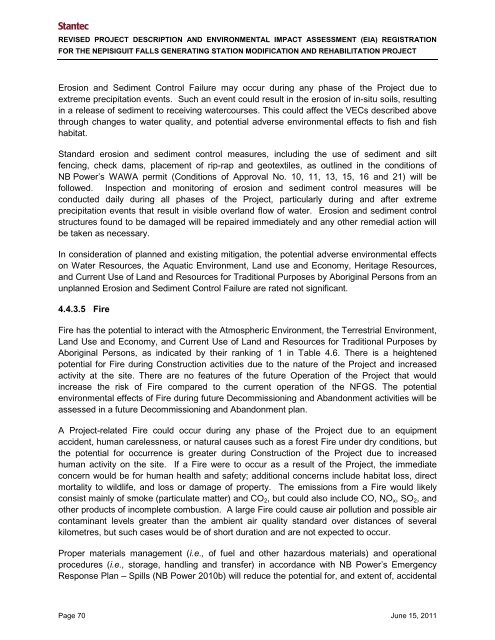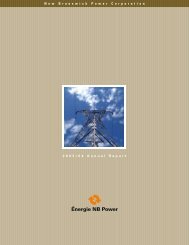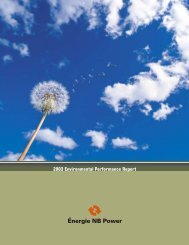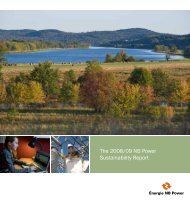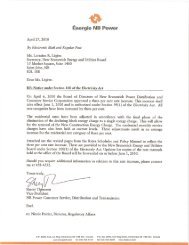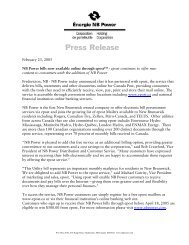Environmental Impact Assessment(EIA) Registration for the ...
Environmental Impact Assessment(EIA) Registration for the ...
Environmental Impact Assessment(EIA) Registration for the ...
Create successful ePaper yourself
Turn your PDF publications into a flip-book with our unique Google optimized e-Paper software.
REVISED PROJECT DESCRIPTION AND ENVIRONMENTAL IMPACT ASSESSMENT (<strong>EIA</strong>) REGISTRATION<br />
FOR THE NEPISIGUIT FALLS GENERATING STATION MODIFICATION AND REHABILITATION PROJECT<br />
Erosion and Sediment Control Failure may occur during any phase of <strong>the</strong> Project due to<br />
extreme precipitation events. Such an event could result in <strong>the</strong> erosion of in-situ soils, resulting<br />
in a release of sediment to receiving watercourses. This could affect <strong>the</strong> VECs described above<br />
through changes to water quality, and potential adverse environmental effects to fish and fish<br />
habitat.<br />
Standard erosion and sediment control measures, including <strong>the</strong> use of sediment and silt<br />
fencing, check dams, placement of rip-rap and geotextiles, as outlined in <strong>the</strong> conditions of<br />
NB Power’s WAWA permit (Conditions of Approval No. 10, 11, 13, 15, 16 and 21) will be<br />
followed. Inspection and monitoring of erosion and sediment control measures will be<br />
conducted daily during all phases of <strong>the</strong> Project, particularly during and after extreme<br />
precipitation events that result in visible overland flow of water. Erosion and sediment control<br />
structures found to be damaged will be repaired immediately and any o<strong>the</strong>r remedial action will<br />
be taken as necessary.<br />
In consideration of planned and existing mitigation, <strong>the</strong> potential adverse environmental effects<br />
on Water Resources, <strong>the</strong> Aquatic Environment, Land use and Economy, Heritage Resources,<br />
and Current Use of Land and Resources <strong>for</strong> Traditional Purposes by Aboriginal Persons from an<br />
unplanned Erosion and Sediment Control Failure are rated not significant.<br />
4.4.3.5 Fire<br />
Fire has <strong>the</strong> potential to interact with <strong>the</strong> Atmospheric Environment, <strong>the</strong> Terrestrial Environment,<br />
Land Use and Economy, and Current Use of Land and Resources <strong>for</strong> Traditional Purposes by<br />
Aboriginal Persons, as indicated by <strong>the</strong>ir ranking of 1 in Table 4.6. There is a heightened<br />
potential <strong>for</strong> Fire during Construction activities due to <strong>the</strong> nature of <strong>the</strong> Project and increased<br />
activity at <strong>the</strong> site. There are no features of <strong>the</strong> future Operation of <strong>the</strong> Project that would<br />
increase <strong>the</strong> risk of Fire compared to <strong>the</strong> current operation of <strong>the</strong> NFGS. The potential<br />
environmental effects of Fire during future Decommissioning and Abandonment activities will be<br />
assessed in a future Decommissioning and Abandonment plan.<br />
A Project-related Fire could occur during any phase of <strong>the</strong> Project due to an equipment<br />
accident, human carelessness, or natural causes such as a <strong>for</strong>est Fire under dry conditions, but<br />
<strong>the</strong> potential <strong>for</strong> occurrence is greater during Construction of <strong>the</strong> Project due to increased<br />
human activity on <strong>the</strong> site. If a Fire were to occur as a result of <strong>the</strong> Project, <strong>the</strong> immediate<br />
concern would be <strong>for</strong> human health and safety; additional concerns include habitat loss, direct<br />
mortality to wildlife, and loss or damage of property. The emissions from a Fire would likely<br />
consist mainly of smoke (particulate matter) and CO 2 , but could also include CO, NO x , SO 2 , and<br />
o<strong>the</strong>r products of incomplete combustion. A large Fire could cause air pollution and possible air<br />
contaminant levels greater than <strong>the</strong> ambient air quality standard over distances of several<br />
kilometres, but such cases would be of short duration and are not expected to occur.<br />
Proper materials management (i.e., of fuel and o<strong>the</strong>r hazardous materials) and operational<br />
procedures (i.e., storage, handling and transfer) in accordance with NB Power’s Emergency<br />
Response Plan – Spills (NB Power 2010b) will reduce <strong>the</strong> potential <strong>for</strong>, and extent of, accidental<br />
Page 70 June 15, 2011


